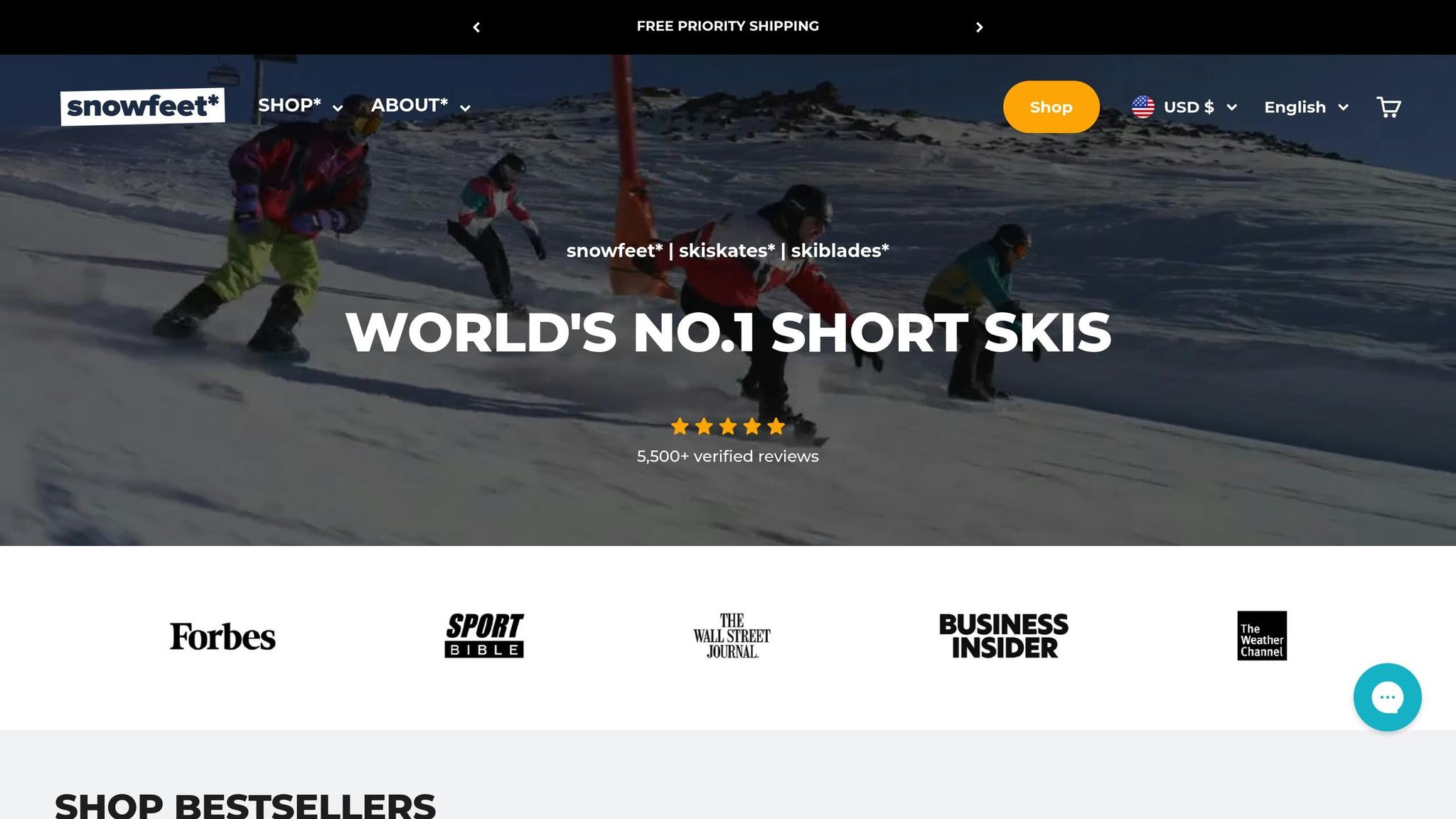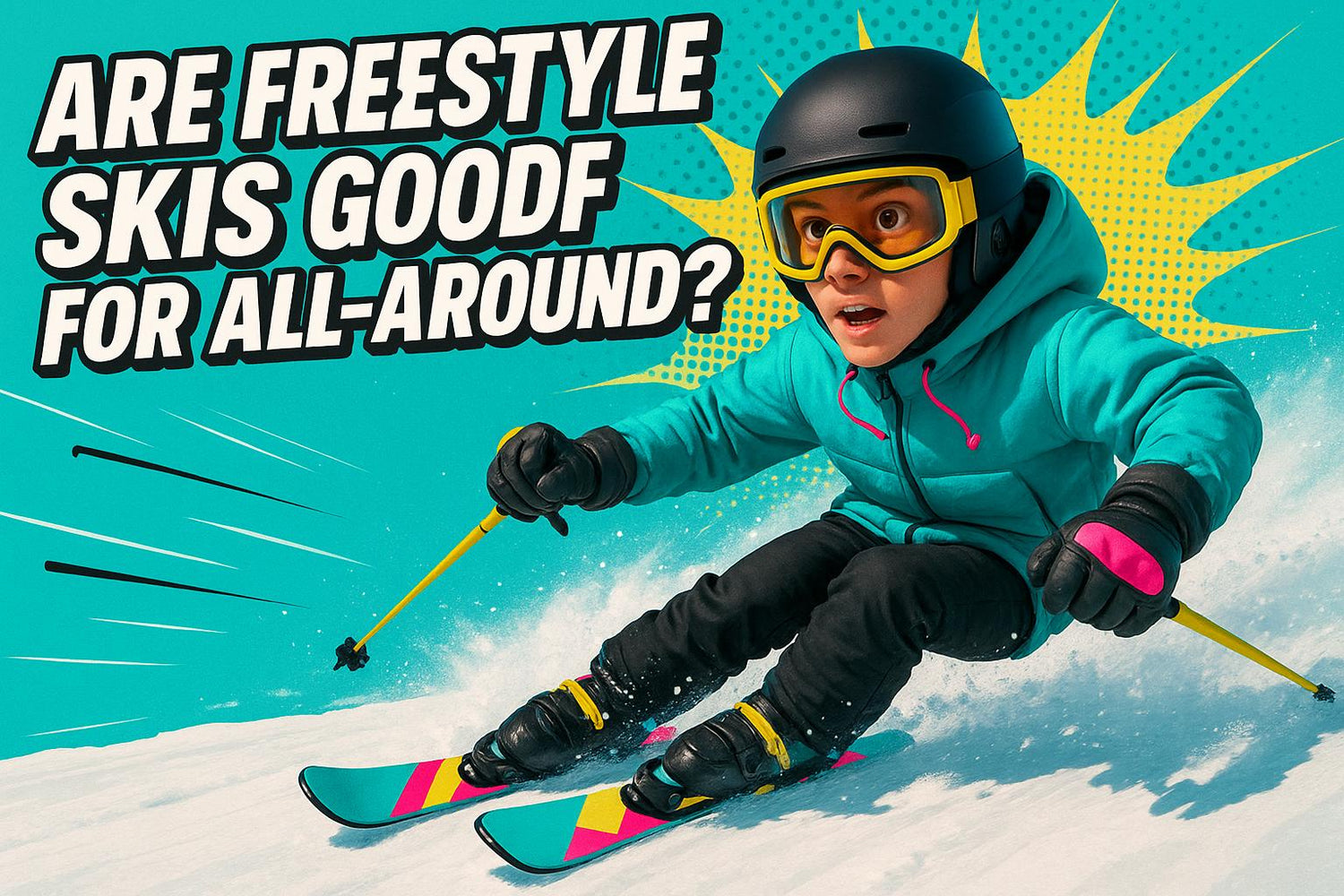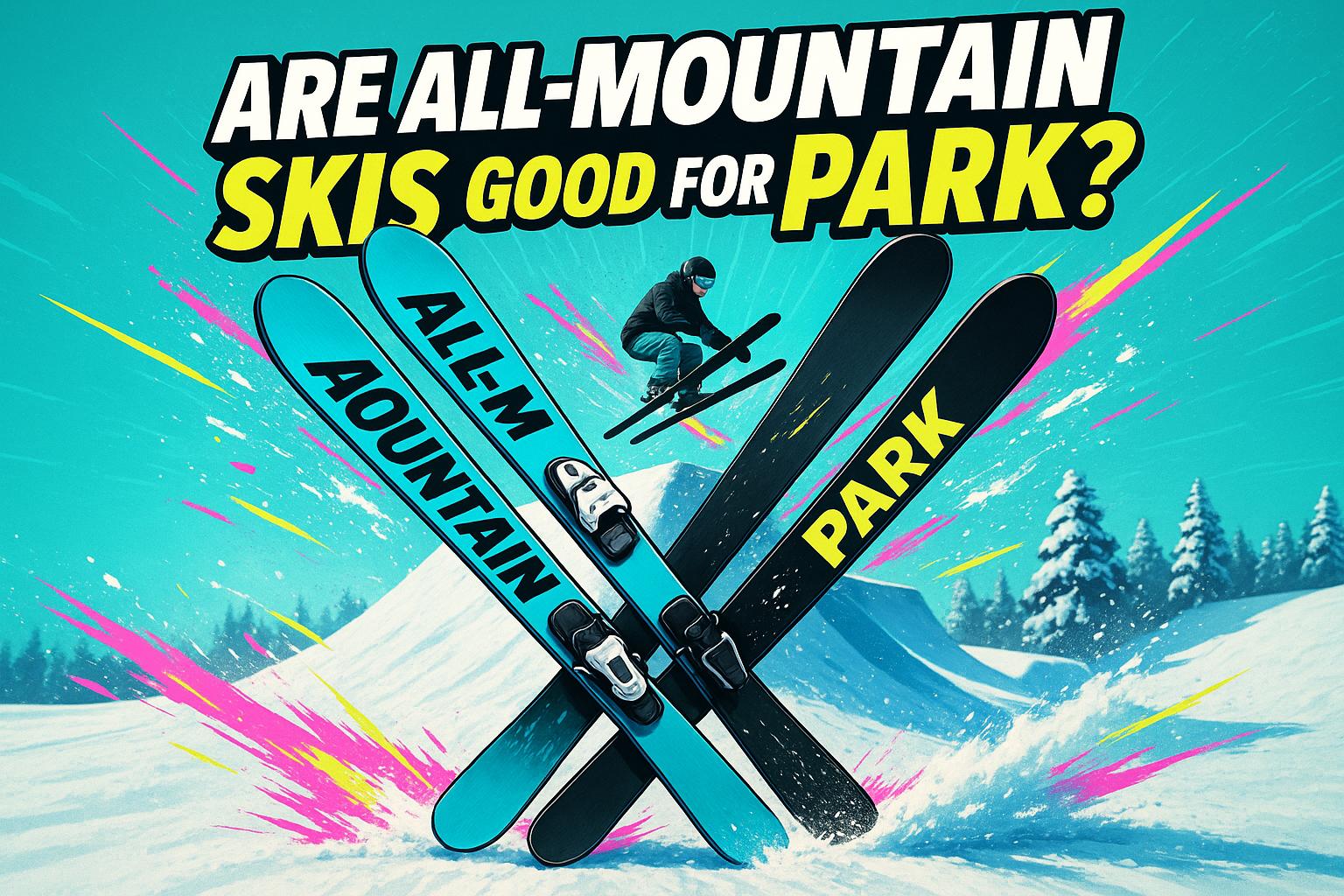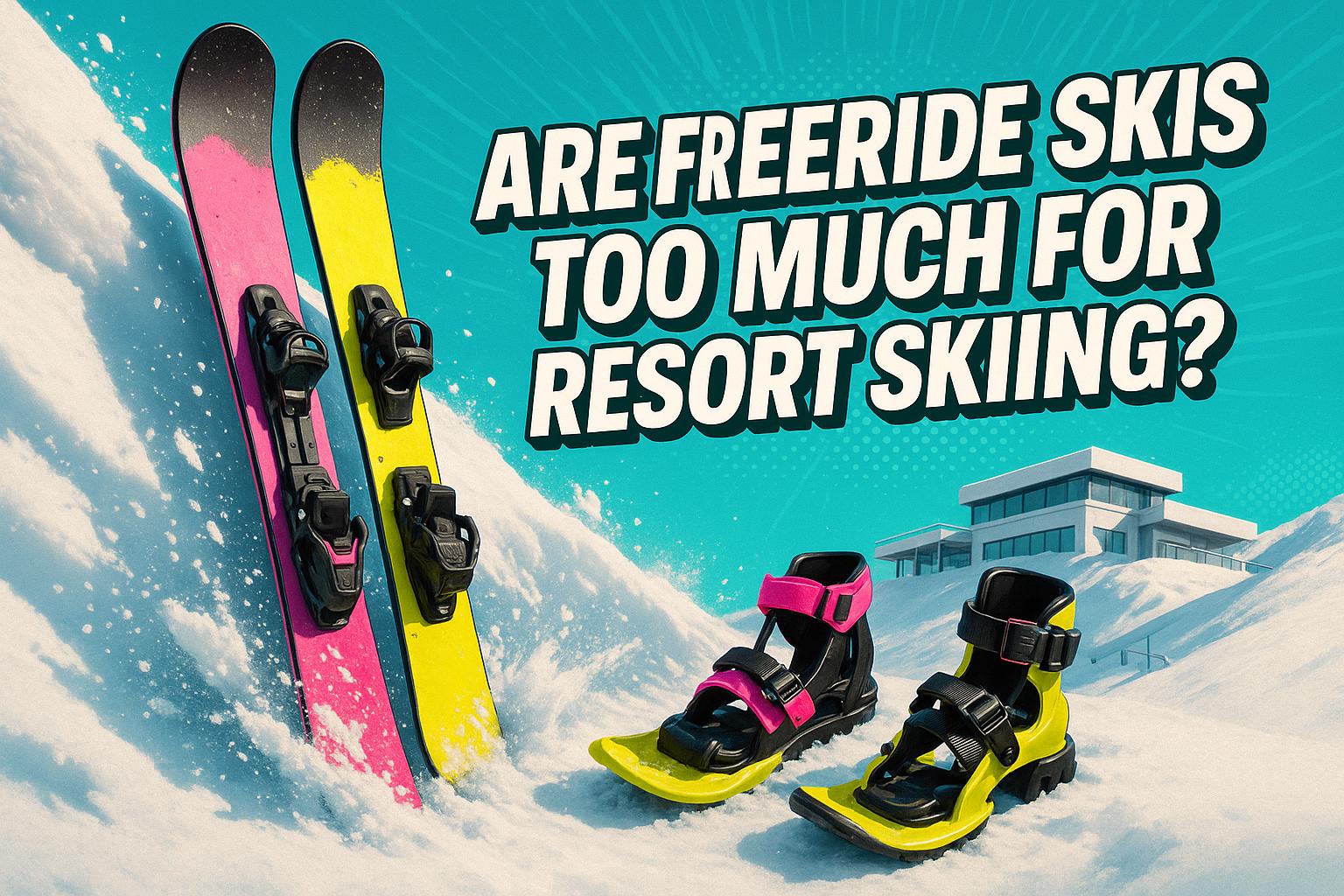Gli sci freestyle sono divertenti e agili, ma non sono i migliori per lo sci in montagna a tutto tondo. Sono progettati per trick, salti e terrain park - ottimi per usi specifici ma meno stabili ad alte velocità o in neve profonda. D'altra parte, gli sci all-mountain gestiscono meglio piste battute, neve fresca e condizioni miste, rendendoli una scelta solida per la versatilità.
Poi c'è Snowfeet*, un'opzione più recente, compatta, portatile e facile da usare. I loro mini ski skates, skiskates e skiblades sono leggeri e si adattano a uno zaino, offrendo un'alternativa divertente per sciatori casual o gite veloci. Non sono ideali per la neve profonda ma brillano su piste battute o sentieri.
Punti chiave:
- Freestyle Skis: Ottimi per i terrain park, ma non stabili per condizioni montane variabili.
- All-Mountain Skis: I migliori per affrontare tutti i tipi di terreno ma possono essere ingombranti e costosi.
- Snowfeet*: Compatti, economici e facili per i principianti, ma limitati nella neve fresca.
Se cerchi versatilità e prestazioni, scegli gli sci all-mountain. Per divertimento casual e portabilità, Snowfeet* vale la pena provarlo. Sci freestyle? Perfetti per il park ma non per la montagna.
COME SCEGLIERE I TUOI SCI
1. Snowfeet* Products (Mini Ski Skates, Skiblades, Skiskates)

Snowfeet* ha rivoluzionato il mondo degli sport invernali con tre linee di prodotti eccezionali che portano una nuova svolta allo sci in montagna. Questi prodotti variano in lunghezza da 15 a 47 pollici, rendendoli super facili da maneggiare e versatili su tutti i tipi di terreni montani. Scopriamo cosa rende speciale ciascuno di essi.
Mini Ski Skates: 15 pollici, 150$; Skiskates: 17 pollici, a partire da 390$; Skiblades: disponibili in 26, 39 e 47 pollici, da 450$ a 690$.
Mini Ski Skates
I Mini Ski Skates sono l'opzione più piccola e leggera della gamma. Con soli 15 pollici, sono abbastanza compatti da poterli mettere nello zaino e sono progettati per funzionare con i tuoi normali scarponi invernali - niente attrezzature speciali richieste. Sono ideali per sfrecciare in un resort o esplorare la montagna in un modo completamente nuovo. Anthony Castaldo lo ha riassunto perfettamente quando ha condiviso la sua esperienza a gennaio 2025, dicendo che dopo aver usato Snowfeet* per diversi giorni li ha trovati sia divertenti da padroneggiare che incredibilmente comodi per muoversi rapidamente. Inoltre, sono un ottimo spunto di conversazione - la gente non smetteva di chiedergli informazioni!
Skiskates
Gli Skiskates sono un ibrido tra sci e pattinaggio, offrendo il meglio di entrambi i mondi. Con un'anima in legno e un design adatto alle piste, sono più veloci dei Mini Ski Skates e offrono una migliore stabilità, mantenendo comunque l'agilità che rende unici i prodotti Snowfeet*. Se cerchi un po' più di velocità e controllo senza sacrificare la manovrabilità, questi potrebbero fare al caso tuo.
Skiblades
Per chi vuole qualcosa di più vicino agli sci tradizionali, gli Skiblades sono la scelta giusta. Disponibili nelle lunghezze di 26, 39 e 47 pollici, sono perfetti per il carving, per gli snowpark e persino per gestire la neve fresca meglio delle opzioni più corte. La loro superficie più ampia li rende la scelta più versatile per affrontare diverse condizioni di neve.
Prestazioni e versatilità
I prodotti Snowfeet* sono progettati per affrontare una varietà di terreni, dalle piste in discesa agli snowpark, sentieri escursionistici e persino colline per slittino. Questo significa che puoi passare da un'attività all'altra senza dover cambiare attrezzatura. Sulla neve battuta, i loro bordi metallici offrono un controllo eccellente, ma la neve profonda (oltre 10 cm) può essere complicata - anche se gli Skiblades la gestiscono meglio grazie alle loro dimensioni e al design simile agli sci.
Portabilità e facilità d'uso
Uno dei vantaggi principali? La portabilità. Dimentica i portapacchi o le borse da sci ingombranti - l'attrezzatura Snowfeet* entra in uno zaino o in una valigia normale, rendendola perfetta per viaggi spontanei. Inoltre, la loro lunghezza più corta li rende più facili da controllare, con transizioni più rapide da un bordo all'altro, ideali per i principianti. Anche i rider esperti adoreranno i nuovi trick e salti che possono eseguire con questi.
La manutenzione regolare, come la sciolinatura della base, li mantiene scorrevoli e previene l'accumulo di neve. E come ha detto NowThis:
"CHI HA BISOGNO DEGLI SCI QUANDO HAI SNOWFEET?" – NowThis
Divertimento a misura di resort
L'attrezzatura Snowfeet* è ben accetta nella maggior parte delle località sciistiche, ma è una buona idea sciare in modo naturale e non attirare troppo l'attenzione sul loro aspetto unico. Che tu sia un principiante o uno sciatore esperto in cerca di qualcosa di diverso, Snowfeet* offre una curva di apprendimento rapida e un modo nuovo di godersi le piste.
2. Sci Tradizionali Freestyle
Gli sci freestyle tradizionali sono fatti con un solo obiettivo in mente: dominare il terrain park. Brillano nei trick su rail, nelle rotazioni e in tutto ciò che riguarda il park, ma non sono esattamente la scelta ideale per le avventure all-mountain.
Design e costruzione
Gli sci freestyle hanno un design twin-tip, perfetto per le manovre nel park, ma non sono ideali per carve su piste ripide o per affrontare condizioni di neve imprevedibili. I loro attacchi sono solitamente montati al centro, il che aiuta con l'equilibrio su rail e trick rotanti. Ma ecco il problema: questa configurazione non è stabile alle alte velocità rispetto alle posizioni di attacco più tradizionali all-mountain.
Sono anche più corti degli sci all-mountain, tipicamente arrivando da qualche parte tra il mento e la fronte quando stai in piedi. Questa lunghezza più corta li rende super agili per i trick, ma significa anche che compromettono stabilità e galleggiamento, cosa che noterai sicuramente nella neve profonda o quando scii su lunghe discese veloci.
Sfide di prestazione all-mountain
Porta gli sci freestyle fuori dal park e il loro design specializzato inizia a mostrare i limiti. Sono come un cavallo a una sola mossa - ottimi in ciò per cui sono fatti, ma non tanto per gestire il terreno vario di un'intera montagna. A velocità più elevate possono risultare instabili e in condizioni di neve variabili mancano della prevedibilità che vorresti.
Sulle piste battute, possono gestire curve base, ma non aspettarti la stessa presa di spigolo o stabilità che avresti con gli sci all-mountain. Il design twin-tip riduce la quantità di spigolo a contatto con la neve, il che significa meno controllo quando spingi davvero. E nella neve fresca? La loro larghezza più stretta (di solito fino a 95mm) e la dimensione compatta li rendono soggetti ad affondare, quindi scivolare nella neve profonda diventa più difficile.
Trasporto e praticità
Un vantaggio degli sci freestyle è la loro lunghezza più corta, che li rende più facili da gestire in spazi stretti come le file affollate agli impianti o nelle aree del rifugio. Sono sicuramente un po' più comodi da trasportare. Detto questo, avrai comunque bisogno di attrezzature adeguate come sacche da sci o portapacchi per tenerli al sicuro.
Il compromesso della durabilità
Gli sci freestyle sono costruiti per durare. Sono più pesanti rispetto agli sci medi, il che è ottimo per resistere a tutto l'abuso che subiscono nel park - rail, box e tutto il resto. Ma quel peso extra può essere uno svantaggio quando cerchi qualcosa di versatile per sciare su tutta la montagna. Questa robustezza ha un costo, soprattutto se confrontata con opzioni all-mountain più adattabili.
3. Sci Tradizionali All-Mountain
Gli sci freestyle e Snowfeet* potrebbero spingere i confini dell'agilità, ma gli sci tradizionali all-mountain sono ancora lo standard d'oro per affrontare una varietà di terreni. Questi sci sono progettati per adattarsi perfettamente a piste battute, powder e anche a tratti ghiacciati, rendendoli la scelta ideale per gli sciatori che vogliono un paio di sci che faccia tutto.
Filosofia di Design e Costruzione
Gli sci all-mountain sono tutto un equilibrio. Con larghezze al centro tipicamente tra 90 e 110 mm, sono progettati per offrire stabilità senza sacrificare la flessibilità. Questo li rende un'opzione solida per sciatori di tutti i livelli di esperienza. La loro costruzione spesso include tecniche avanzate per aumentare la presa, la reattività e la stabilità complessiva. Caratteristiche come profili rocker e forme di sidecut su misura sono aggiunte per migliorare la manovrabilità, così puoi affrontare tutto, dalla neve compatta alla powder fresca.
Prestazioni in Diverse Condizioni Montane
Sui sentieri battuti, questi sci offrono una presa affidabile sui bordi e rimangono stabili anche a velocità più elevate. Quando si tratta di powder, il loro design leggermente più largo e la lunghezza maggiore forniscono una migliore galleggiabilità, aiutandoti a scivolare sulla neve invece di affondare. La maggior parte degli sci all-mountain ha anche un raggio di curva tra 14 e 18 metri, offrendo la versatilità per affrontare sia percorsi stretti tra gli alberi che ampie piste con facilità.
Esempi di Prestazioni nel Mondo Reale
Diversi modelli mostrano la versatilità degli sci all-mountain:
- Nordica Enforcer 94: Conosciuto per eccellere in tutti i tipi di condizioni.
- Völkl M7 Mantra: Lodato per la sua stabilità rocciosa e la capacità di carving precisa, anche ad alte velocità.
- Salomon QST 92: Un'opzione indulgente che offre comunque un buon controllo del bordo e versatilità a tutto tondo.
"Questo è un vero sci unico per uno sciatore forte. Vuole essere sciato a tutta velocità, a tutto gas - ma è reattivo ed energico nei punti stretti." – Chad Jacob, Allenatore di Sci Racing a Bristol Mountain, NY
I compromessi della lunghezza tradizionale
La lunghezza maggiore degli sci all-mountain tradizionali è una lama a doppio taglio. Da un lato, aggiunge stabilità e aiuta la galleggiabilità nella neve più profonda. Dall'altro, può far sentire gli sci meno agili in aree strette e affollate. Inoltre, le loro dimensioni possono rendere lo stoccaggio e il trasporto un po' complicati. Per gli sciatori che danno priorità alla comodità o alla manovrabilità rapida, questi aspetti potrebbero essere un problema.
Considerazioni su Costo e Accessibilità
Gli sci all-mountain sono disponibili in una vasta gamma di prezzi. Le opzioni entry-level partono da circa 600$, mentre i modelli di fascia alta possono arrivare a 1.299$ o più. Per esempio:
- Line Pandora 99: Un'opzione giocosa e versatile a 600$.
- Stöckli Stormrider 95: Una scelta premium a $1,299, che offre una guida fluida e stabile.
"Questo è lo sci all-mountain che si adatta a una vasta fetta di mercato. Gli sciatori avanzati ameranno la sua potenza e la sensazione da gara orientale, mentre gli sciatori occidentali apprezzeranno la facile iniziazione alla curva e l'ampia galleggiabilità." – Rob Hudson, sciatore del Colorado e ex collaboratore di Outside
Sebbene il costo iniziale degli sci all-mountain possa essere elevato, la loro durata e la capacità di affrontare diverse condizioni li rendono spesso un investimento valido. Detto ciò, potrebbero non essere la scelta migliore per principianti o per chi cerca un ingresso economico nello sci.
sbb-itb-17ade95
Pro e contro
Confrontando i prodotti Snowfeet*, gli sci freestyle tradizionali e gli sci all-mountain, è chiaro che ogni opzione ha i propri punti di forza e compromessi. Analizziamoli.
I prodotti Snowfeet* si distinguono per la loro semplicità e comodità. Sono compatti, portatili e perfetti per uscite improvvisate. I principianti adoreranno la curva di apprendimento minima - non servono lezioni! Funzionano bene su piste, sentieri o anche nel tuo cortile. Tuttavia, non sono la scelta migliore per la neve profonda.
Gli sci freestyle, invece, sono progettati per i terrain park. Gestiscono salti e rail come professionisti e offrono una migliore galleggiabilità nella neve fresca rispetto agli sci più corti. Tuttavia, hanno una curva di apprendimento più ripida e sono più specializzati, rendendoli meno versatili per un uso montano generale.
Gli sci all-mountain sono la scelta ideale per la versatilità. Dalle piste battute alla neve fresca, offrono prestazioni equilibrate in varie condizioni. Detto ciò, tendono a essere più costosi e possono risultare meno agili negli spazi stretti.
Ecco un rapido confronto per aiutarti a decidere:
| Caratteristica | Prodotti Snowfeet* | Sci tradizionali Freestyle | Sci tradizionali All-Mountain |
|---|---|---|---|
| Portabilità | Compatto e adatto allo zaino | Ingombrante; spesso necessita di un portapacchi | Ingombrante; spesso necessita di un portapacchi |
| Curva di apprendimento | Super facile; non servono lezioni | Da moderato a ripido | Moderato |
| Fascia di prezzo | $150–$690 | $400–$800 | $600–$1,299 |
| Prestazioni nella neve fresca | Galleggiamento limitato | Galleggiamento migliore | Eccellente galleggiamento |
| Versatilità del terreno | Ottimo per pendii, sentieri e cortili | Ideale per parchi e piste battute | Funziona bene nella maggior parte delle condizioni di montagna |
| Conservazione | Spazio minimo necessario | Richiede molto spazio per la conservazione | Richiede molto spazio per la conservazione |
| Manovrabilità | Altamente reattivo | Reattività moderata | Meno maneggevole in spazi ristretti |
| Compatibilità con gli scarponi | Funziona con scarpe invernali e scarponi da sci | Progettato per scarponi da sci | Progettato per scarponi da sci |
Il prezzo è un altro fattore chiave. I prodotti Snowfeet* sono economici, con Mini Ski Skates a partire da soli $150, mentre gli sci all-mountain possono arrivare fino a $1.299. Come ha detto un utente, Nathan F.:
"Altamente impattante! Sono leggeri, veloci e incredibilmente divertenti da usare."
L'attrezzatura Snowfeet* funziona anche per tutte le età, dai 5 ai 105 anni. Questo significa che le famiglie possono risparmiare sia sui costi che sullo spazio, evitando la necessità di più taglie o modelli come spesso richiedono gli sci tradizionali. Inoltre, i pezzi di ricambio per i prodotti Snowfeet* partono da soli $6, mantenendo bassi i costi di manutenzione.
Per sciatori seri che vogliono attrezzatura in grado di affrontare giornate di polvere estrema, piste ghiacciate o curve ad alta velocità, gli sci tradizionali potrebbero ancora essere la scelta migliore. In definitiva, la tua scelta dipende dal tuo stile di sci e da quanto spesso vai sulle piste. Abbinare l'attrezzatura alle tue esigenze è ciò che fa davvero la differenza!
Conclusione
Gli sci freestyle sono la scelta migliore per lo sci in montagna a tutto tondo? Beh, dipende davvero da ciò di cui hai bisogno. Gli sci freestyle brillano nel park, mentre gli sci all-mountain dominano nella polvere profonda e nelle curve ad alta velocità. Ma spesso hanno prezzi più alti, maggiori esigenze di spazio e una curva di apprendimento più ripida.
Entra in gioco Snowfeet*. Questi prodotti intelligenti cambiano completamente le regole. Con prezzi che vanno da $150 a $690, sono un'opzione economica che funziona con le tue scarpe invernali abituali. Questo li rende super accessibili per i principianti - sciare sembra naturale quando i tuoi piedi possono muoversi indipendentemente. Snowfeet* unisce l'agilità degli sci da park con la praticità dell'uso quotidiano in montagna.
Cosa c'è di ancora più bello? Snowfeet* non è solo per le piste. A differenza degli sci tradizionali che ti legano ai resort, Snowfeet* ti permette di esplorare sentieri, colline nel cortile o ovunque ci sia neve. Il loro design leggero e portatile significa che puoi metterli in valigia e partire ogni volta che ti va.
Snowfeet* è perfetto per sciatori amatoriali che vogliono il massimo divertimento senza complicazioni, famiglie in cerca di una conservazione più facile e costi inferiori, e chiunque ami un'atmosfera invernale flessibile e ovunque. Certo, se stai cercando prestazioni d'élite in condizioni estreme, gli sci tradizionali potrebbero ancora essere la tua scelta. Ma per un divertimento puro e senza stress che si integra perfettamente nel tuo stile di vita, Snowfeet* è difficile da battere.
Domande frequenti
I prodotti Snowfeet possono affrontare lo sci in montagna a tutto tondo come gli sci tradizionali?
Perché scegliere Snowfeet per le avventure in montagna?
L'attrezzatura Snowfeet porta una ventata di novità nello sci in montagna. A differenza degli sci tradizionali, che possono essere ingombranti e pensati per condizioni specifiche, i prodotti Snowfeet sono leggeri, compatti e super facili da trasportare. Che tu stia scivolando giù per piste battute, affrontando il terrain park o persino percorrendo sentieri da sci di fondo, queste piccole meraviglie sono pronte alla sfida. Inoltre, il loro design li rende una scelta eccellente per i principianti - offrendo un'esperienza divertente e agile senza la sensazione opprimente degli sci di dimensioni normali.
Inoltre, l'attrezzatura Snowfeet è costruita per durare. Offre prestazioni solide sia che tu stia scendendo in velocità sia che ti avventuri in zone di montagna meno tradizionali. Mentre gli sci tradizionali possono eccellere in certe situazioni, Snowfeet si distingue per portabilità, facilità d'uso e capacità di affrontare vari terreni. È un'ottima opzione versatile per chiunque voglia variare le esperienze in montagna.
Gli sci freestyle possono affrontare sia i terrain park che lo sci all-mountain?
Gli sci freestyle sono pensati per combinare agilità e versatilità, rendendoli una scelta solida per chi ama sia i terrain park che lo sci all-mountain. Grazie al loro design twin-tip e a un mix di profili camber e rocker, questi sci offrono la stabilità necessaria su diversi terreni permettendo di eseguire trick e mosse giocose nel park.
Snowfeet porta questo concetto ancora più avanti con attrezzature di spicco come Skiblades e Skiskates. Sono leggeri, compatti e super facili da usare, dando agli sciatori la libertà di esplorare la montagna e divertirsi nel park. Se cerchi attrezzatura portatile, divertente e pronta per l'avventura, Snowfeet potrebbe essere la tua prossima scelta.
Snowfeet sono una buona alternativa agli sci tradizionali all-mountain per lo sci casual?
Snowfeet portano una ventata di novità allo sci casual, offrendo un'alternativa divertente agli sci tradizionali all-mountain. Con il loro design compatto e leggero, sono facilissimi da trasportare, conservare e portare con sé. Dimentica di trascinare attrezzature pesanti e ingombranti: questi si infilano comodamente in uno zaino, rendendo i tuoi viaggi sugli sci molto più semplici.
Ciò che davvero distingue Snowfeet è il loro design agile e giocoso. Sono perfetti per curve rapide e divertimento senza sforzo sulle piste, offrendo un'esperienza rilassata e accessibile, ideale per principianti o chiunque voglia godersi lo sci senza stress. Mentre gli sci tradizionali si concentrano su velocità e stabilità ad alte velocità, Snowfeet brillano per versatilità e facilità d'uso. Sono ideali per affrontare diversi terreni senza anni di pratica. Se portabilità e un modo senza pressioni per affrontare la montagna ti attirano, Snowfeet potrebbero diventare la tua nuova attrezzatura preferita.


































Lascia un commento
Questo sito è protetto da hCaptcha e applica le Norme sulla privacy e i Termini di servizio di hCaptcha.